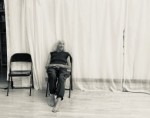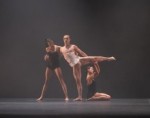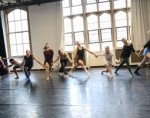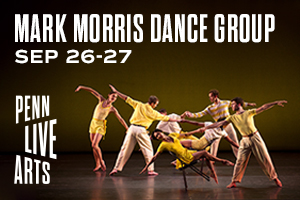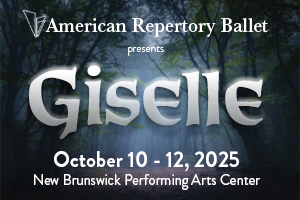
Dancing Beyond the Void
by Brendan McCall
How do queer dance artists address the AIDS epidemic of the '80s and '90s when they weren't even born yet? What is the relationship between this painful yet important part of queer history and the lives of younger LGBTQ people today?
Emerging choreographer Julian Donahue stated that the seed for With Violets In Her Lap, which premiered this spring at the LGBT Community Center in Greenwich Village, started in 2019 while still a college student. In a March interview with Susana Mejia, Donahue shared that he envisioned this one-man dance performance as a “requiem for all the queer people lost to AIDS” (1). He admitted that he was rather intimidated by the subject matter; did he possess the “personal or artistic gravitas to tackle a project with such depth,” he wondered? But the gut-punch of the US Presidential election results last November galvanized him; creating this piece became a necessity.
Donahue appears wearing all black; a neutral white mask keeps his facial expressions initially hidden. As the achingly beautiful sounds of “Introitus” from Mozart's Requiem in D Minor plays, he crosses the stage diagonally at durge-pace before tossing his hands upwards. Flower petals scatter, and the rigor unfolds for nearly 90 minutes.
The choreography Donahue has crafted for himself shows his exceptional gifts, his classical ballet technique evident throughout much of With Violets in Her Lap. He exudes muscular mastery as he leaps into the air or balances on the ball of one foot, or when he silently collapses onto the floor on the side of his torso, his spine arching in a dramatic image of struggle and angst. Without his mask, Donahue’s performance especially feels like a battle, embodying a warrior-like beauty.
Violets symbolize humility and remembrance, but the flower has been associated with the queer community at least since Sappho. Donahue's program notes quote Aaron Betsky (Queer Space: Architecture and Same-Sex Desire) and V, formerly known as Eve Ensler (The Vagina Monologues), contextualizing the performance to be about the AIDS crisis. The young artist himself has stated on his social media that he hoped to reflect upon that period of the AIDS epidemic from a “queer Gen Z perspective.” Donahue's music selection also does a lot of the narrative work here: in addition to a series of movements from Requiem, we heard a number of tracks from the queer legend Sylvester.
The sharp lines of the earlier classical vocabulary melt away, as the infectious pulse of disco and Sylvester’s trademark falsetto fills the room. Audience members around me all began moving in their seats as Donahue´s torso undulated side-to-side, or stepped to the beat. His body movement became less balletic and more personal, as if we were suddenly transported to a gay club downtown just starting to get hot. Occasionally, Donahue would mix in some of his more virtuosic feats from earlier, blending them with a more sensual sway of his hips or even a pause to douse his face in some water. With Violets in Her Lap alternates between these two “worlds” of Mozart/classical dance with Sylvester/club dance (perhaps repeating a few too many times, and diminishing some of its initial power during the final 30 minutes of the performance), perhaps implying that one of the best way to confront death is to dance. Whether it is AIDS or any other incomprehensible grief, the sweaty movement and community we can all find on the dance floor might be our salvation.
Without reading the program in advance, I am uncertain whether With Violets in Her Lap would be perceived as being about the AIDS epidemic. Or to rephrase: this ambitious work is about more than this dark chapter from queer history. As Donahue´s solo unfolded with gestures of grace and images of anguish, I was reminded of Kurt Jooss´ The Green Table. While originally performed in 1932, that anti-war ballet touches upon something timeless and universal, beyond the singular historical circumstances that might have inspired it. Similarly, With Violets in Her Lap is certainly a powerful lament for the LGBTQ people we have lost in the 1980s-90s, but it is also about something beyond. Through rigor and pleasure, from high art to pop, Donahue offers us a balm for whatever ails us. With Violets in Her Lap is filled with heartfelt emotion as well as moments of stunning physical prowess, a reminder for all of us during these dark times to dance–to dance, baby, and never ever stop.
(1) “Powerful interests are betting we forgot the AIDS crisis,” by Susana Meija. Of Note (Substack), March 15, 2025.
With Violets In Her Lap, The LGBT Center, April 25-26.
Homepage Image Description: A young man, nude and with his face hidden, squeezes his legs together while his arms are curved downward from his sides, as if his fists are carrying two imaginary buckets. He is in a room next to a white sofa, in front of an abstract painting composed of light blue strokes, and with a vase of violets near his feet.
Article Image Description: A young man facing the right, wearing black shorts and matching black t-shirt, beautifully extends his left arm forward and right leg back.
By Brendan McCall
May 19, 2025


